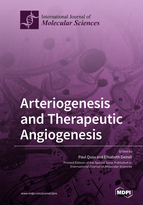Arteriogenesis and Therapeutic Angiogenesis
A special issue of International Journal of Molecular Sciences (ISSN 1422-0067). This special issue belongs to the section "Molecular Pathology, Diagnostics, and Therapeutics".
Deadline for manuscript submissions: closed (1 September 2021) | Viewed by 44115
Special Issue Editors
2. Einthoven Laboratory for Experimental Vascular Medicine Leiden University Medical Center, 2333 ZA Leiden, The Netherlands
Interests: experimental vascular medicine; blood vessel; arteriogenesis
Special Issues, Collections and Topics in MDPI journals
Interests: cardiovascular research; immunology
Special Issues, Collections and Topics in MDPI journals
Special Issue Information
Dear Colleagues,
This Special Issue will welcome original research articles and review papers on all molecular aspects of arteriogenesis and therapeutic angiogenesis. Potential topics include, but are not limited to, the following:
- Genetic and Environmental Mechanisms Controlling Formation and Maintenance of the Native Collateral Circulation;
- Arteriogenesis, Therapeutic Angiogenesis and Peripheral Arterial Disease;
- The Formation of Collateral Arterial Networks: Insights from the Developing Embryo;
- Notch Signaling in Arteries: From Embryonic Development to Postnatal Homeostasis and Growth;
- Multiple Pathways Converge in the Development of a Collateral Circulation
- (Arteriogenesis);
- Fluid Shear Stress and its Pathways in Arteriogenesis;
- Cell and Gene Therapy in Peripheral Arterial Disease;
- Epigenetic Mechanisms and Arteriogenesis;
- Non-Coding RNA in vascular remodeling during arteriogenesis and angiogenesis
- Bone Marrow Derived Cells in Arteriogenesis;
- Local and Sustained Drug Delivery in Arteriogenesis;
- Collateral Artery Growth in Man, from Assessment to Stimulation;
- Therapeutic angiogenesis, from Assessment to Stimulation
Prof. Dr. Paul Quax
Prof. Dr. Elisabeth Deindl
Guest Editors
Manuscript Submission Information
Manuscripts should be submitted online at www.mdpi.com by registering and logging in to this website. Once you are registered, click here to go to the submission form. Manuscripts can be submitted until the deadline. All submissions that pass pre-check are peer-reviewed. Accepted papers will be published continuously in the journal (as soon as accepted) and will be listed together on the special issue website. Research articles, review articles as well as short communications are invited. For planned papers, a title and short abstract (about 100 words) can be sent to the Editorial Office for announcement on this website.
Submitted manuscripts should not have been published previously, nor be under consideration for publication elsewhere (except conference proceedings papers). All manuscripts are thoroughly refereed through a single-blind peer-review process. A guide for authors and other relevant information for submission of manuscripts is available on the Instructions for Authors page. International Journal of Molecular Sciences is an international peer-reviewed open access semimonthly journal published by MDPI.
Please visit the Instructions for Authors page before submitting a manuscript. There is an Article Processing Charge (APC) for publication in this open access journal. For details about the APC please see here. Submitted papers should be well formatted and use good English. Authors may use MDPI's English editing service prior to publication or during author revisions.
Keywords
- Arteriogenesis
- Angiogenesis
- Collateral Formation
- Peripheral Arterial Disease
- Cell and Gene Therapy
- Critical Limb Ischemia
- Therapeutic angiogenesis
- Collateral Circulation








